Ask any designer you know about their professional pet peeves and the most likely answer wouldn’t be anything design- or creativity-related. It’s bound to be something related to their stakeholders.
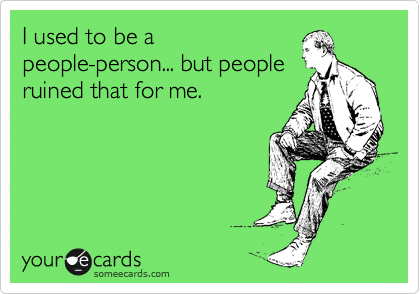
Carrying out insightful research, designing for your users, and understanding the business goals… they’re the easy parts. Getting stakeholder buy-in on those designs or coaxing them to follow research recommendations, well, that’s a different battle altogether.
And, there’s research that proves it.

Communication between UX design and the rest of the stakeholders is quite like playing a team sport. Think of synchronized swimming, for instance, where everyone is performing their own moves but it looks seamlessly unified.
Now, not all teams, wait, let us scratch that. No product team ever will function as efficiently as those graceful swans, but as long as you don’t have the animated on-field screaming of a soccer coach, you’re good.
Some stakeholders are a pleasure to work with, others not so much, that’s just the way it is in the real world. Overbearing PMs, nonchalant developers, and interfering department leads create a difficult mix that the UX leads have to handle. However, there is a way to navigate through stakeholder communication without bruising egos, let’s take a look.
Dealing with Stakeholders
Step One Identify your Stakeholders
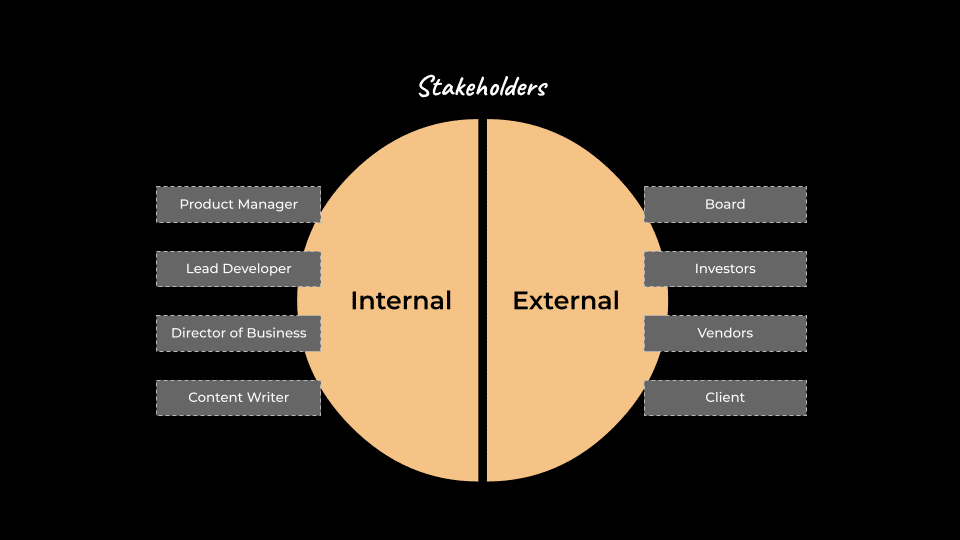
By definition, a stakeholder is a person who may be affected by what we’re doing or can influence its success.
As a UX representative, you will typically have to deal with 2 types of stakeholders –
- Internal
- External
The internal stakeholders could be your reporting head, people from engineering, or product management. They may also be from other teams you might interact with such as sales or customer service.
Your primary external stakeholder is your client, of course, along with board members, investors, and vendors. Technically, your end users are stakeholders as well. As UX practitioners, your main focus (your design expertise) has to be on users as your primary stakeholders.
However, those design skills of yours can only get you that far with your other stakeholders – you need to be adept at getting them to work with you and not against you.
Decoding the stakeholder landscape
A year ago, we were working on an internal CRM tool for a fintech client that involved a bunch of stakeholders from IT, leadership, business operations, and product development. Of course, each stakeholder brought their own agenda to the discussion table.
The CEO wanted to prove his mettle before the board.
The newly-hired VP of Product was an eyesore to some of the team members who thought they’d be a better fit. He wanted to justify his hiring.
The IT head just wanted to spend her budget so it wouldn’t be cut down in the next cycle.
The Lead of Product Development was tired of the legacy tech the CRM was built on, and wanted to migrate to new technology through this project.
To add to this, we were hired because there was a lot of redundancy in workflows, and streamlining the UX also meant a change in business processes and shuffling of jobs. This directly impacted the Head of Business Operations, who was against the whole idea from day one. He was the showrunner for 16 years and considered our presence a territorial breach.
A messy but common occurrence across industries and organizations, which means that it can be resolved.
Step Two Conduct Interviews
Stakeholder interviews are the best way to intensify our connection with them and build a shared understanding of what are we doing and why.

When stakeholders are new you can start by asking them questions about their roles, backgrounds, personalities, what are their calendar norms, what is their communication preferences, and so on.

While this might sound trivial, remember that people feel great talking about themselves. Plus, knowing these details gets a lot of things streamlined from the beginning as opposed to discovering them as you go.

When the stakeholders are already familiar, the focus of the questionnaire becomes understanding their perspective of the business goals. You need to get an insider view of what they think of the current solution, and what constraints they think will remain or go away as you embark on the project. Most importantly, you need to get them onboard with the success metrics.
The one-on-one setting of stakeholder interviews along with having a focused agenda lets us go deeper and truly understand our stakeholders. The insights then drive us to engage them better for the success of the project.
Step Three Map your Stakeholders
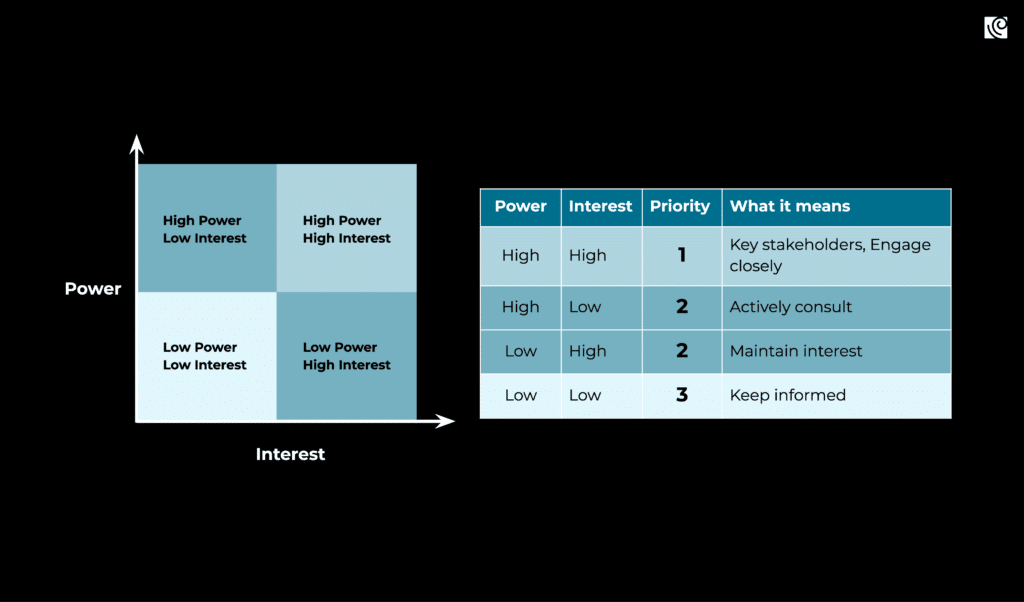
This power-interest matrix is a great technique to identify key stakeholders, and how to deal with the different types including the difficult ones as well.
For the power-interest matrix, you have to map out stakeholders depending on their level of interest in your work, and their power and influence over it.
This will help you to identify and slot them into the following categories –
Manage closely
These are key stakeholders, those with high interest and high influence. This is where you should focus your energies, especially on any key stakeholders who are or are likely to be difficult to work with.
Keep satisfied
These are stakeholders with low interest but wield a high level of influence. They can often be the most difficult to deal with because there are fewer opportunities to work together, and engagement might be low. It’s important to proactively manage these stakeholders and to think about how you can keep them satisfied so that their influence remains positive.
Keep informed
These would be stakeholders with high interest but minimal influence. Remember to keep them informed. Don’t stress too much about any difficult stakeholders in this group unless their influence could grow over time.
Monitor
While it is a good practice to remain aware of stakeholders with minimal influence and interest, it’s generally not worth spending a lot of effort on this group. It might be nice to improve your working relationships with any difficult stakeholders, but it need not be a priority.
Step Four Document your Research
Armed with the data from your stakeholder interviews, the next step is to encapsulate all the information by creating stakeholder profiles for individual key stakeholders. This can be done in phases, starting with primary and difficult stakeholders. Revisit the stakeholder profiles every time you start a new initiative or project and add, remove, or tweak the existing ones based on the current situation.
A stakeholder profile contains key information about the stakeholders, as shown in the template below –
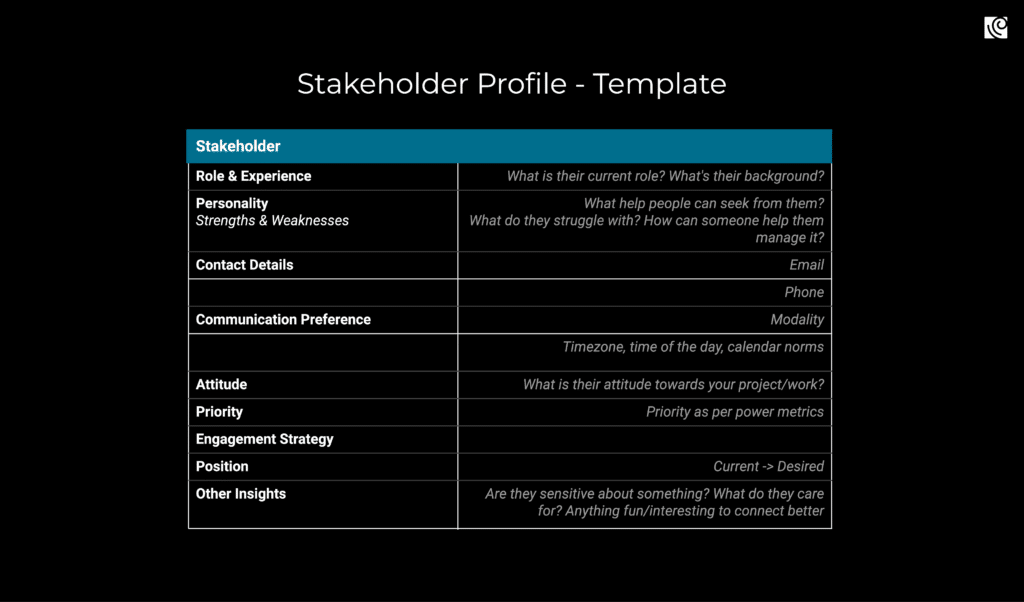
You could associate a personality trait to your profile, as you learn about them.
For eg. your priority 1 stakeholder could be a bully. How do you come to that conclusion?
When the loudest voice in the room belongs to them. They’re aggressive and impatient. They lack emotional maturity and are dismissive of anyone else’s opinion. They can easily turn hostile and will intimidate their soft targets. That’s a bully.
There might be other personality types you might be dealing with, especially the ones that make a stakeholder difficult to deal with when you have someone on your list who is a visionary, a toxic person, a bully, or simply a disengaged stakeholder.
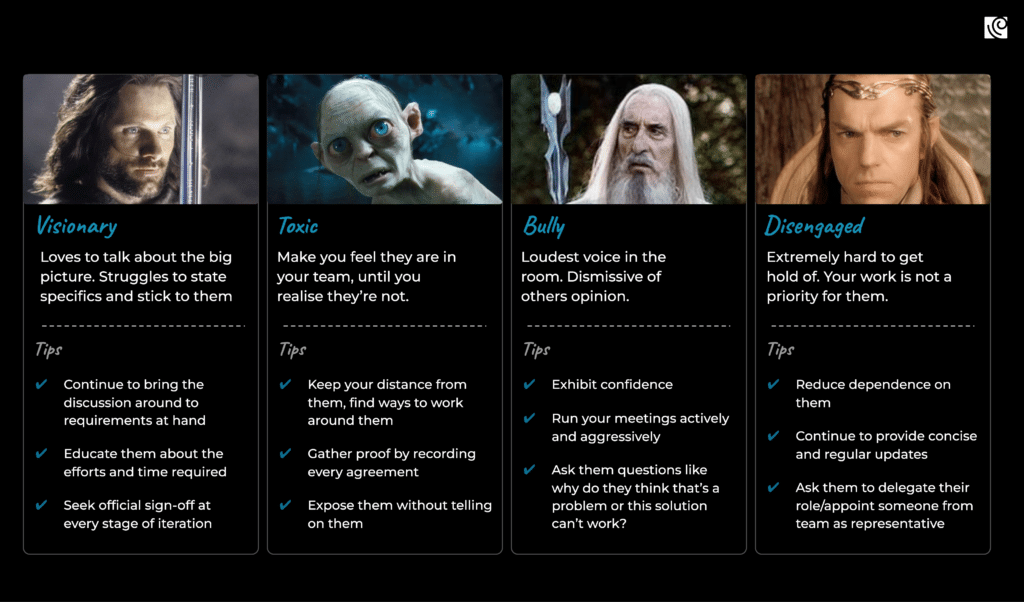
Tips for dealing with different stakeholder types
- Trace the difficult stakeholder on the stakeholder map, so you’re aware of how much to worry about and the amount of effort needed to engage them. Have your game plan ready when confronting a difficult stakeholder.
- Do not employ a lot of effort on a stakeholder who makes a lot of noise but is not a high priority.
- If it’s an important stakeholder, analyze what’s driving this behavior. Is it an attitude problem or a personality trait?
- Remember to be mindful when you choose to shift their position – you don’t need everybody to be cheering for you. You just want them in a position that’s good enough based on their priority.
Step Five Devise your Engagement Plan
And now to the final step of the plan to get buy-in from stubborn stakeholders. To turn things into a meaningful conversation instead of one-sided criticism. To transform someone who seems like an enemy into an engaged collaborator.
Stakeholders from diverse backgrounds bring a wealth of perspectives and ideas. Encourage it by actively seeking input from individuals across departments with different backgrounds, experiences, and skill sets. Here’s a template to engage them with tact.

TL;DR before we conclude
Don’t alienate the difficult stakeholders – Involve them to witness the design process. Help them gain a better understanding and then provide feedback. Remove group dynamics by working with difficult stakeholders individually.
Speak your stakeholders’ language – Use terminology that they’re familiar with and comfortable with. Have open and honest conversations and be candid about issues to be resolved.
Earn stakeholder trust – Set down some positive and realistic KPIs to earn trust and show what good design and research can achieve.
Share your work actively– Set up show-and-tell sessions to share your work in a way that is easy for stakeholders to digest.
Hold frequent check-ins– Set up regular check-ins, especially with difficult stakeholders, either in-person or via video call.
Smooth and effective cross-functional collaboration may seem like a utopian dream, but it’s possible to make that a reality. In all honesty, this collaboration is at the root of optimizing performance, driving innovation, tackling complex issues, and making informed decisions in today’s competitive business landscape.









